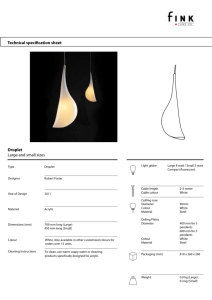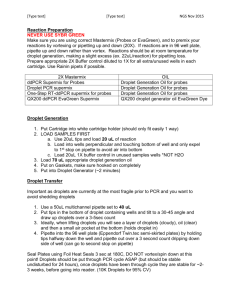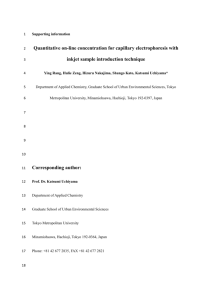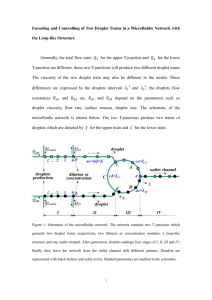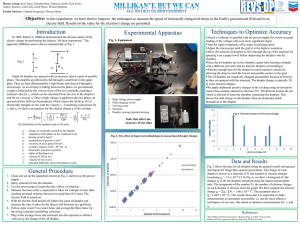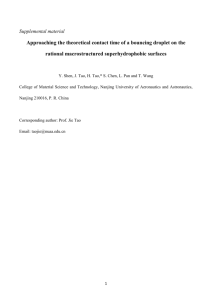Evaporation in low pressures
advertisement
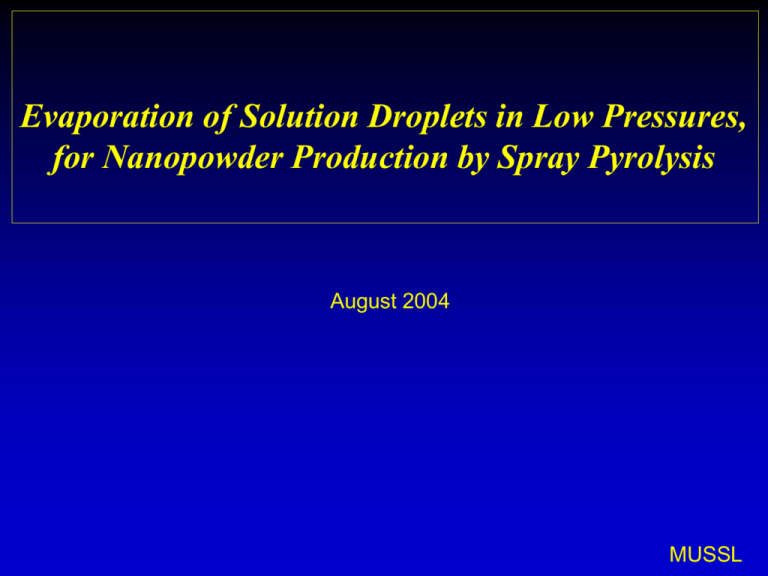
Evaporation of Solution Droplets in Low Pressures, for Nanopowder Production by Spray Pyrolysis August 2004 MUSSL Outline Introduction Objective Experimental set-up Future Work Theoretical Model Timetable MUSSL Introduction: Spray Pyrolysis MUSSL Crust Formation MUSSL Zirconia Production Zirconium nitrate ZrO(NO3)2.xH2O ZrO2 + NO2+H2O Decomposition temperature: 270 0C Zirconium chloride ZrOCl2.8H2O ZrO2 + HCL + H2O Decomposition temperature: 380 0C Zirconium acetate Zr(CH3COO)4 +H2O ZrO2 + CO2 + HCL Decomposition temperature: 320 0C MUSSL Modeling Nanopowder Production Nanopowder production in the atmospheric pressure occurs in the Transition Regime: Kn~1 Actual case P=101 kPa d=100 nm Kn=1.8 Kn 2 d Modeled case P=0.05 kPa d=200,000 nm Kn=1.8 MUSSL Evaporation in low pressures Continuum assumption is no longer valid when the pressure is relatively low. For low density gases in equilibrium the kinetic theory applies. Nanopowder production occurs in the transition regime and in this region the Boltzmann equation should be solved for the velocity distribution. Evaporation data of solution droplets for low pressures is very sparse in the literature. MUSSL Objectives Experimental investigation on the effect of operating conditions (Chamber P, T, φ, and droplet D and Cin) on the morphology of nanopowders of ZrO2. Experimental investigation on the single droplet evaporation in low pressures. MUSSL Important Issues Chamber heating in low pressures Adequate chamber height Uniform droplet generation Accurate imaging MUSSL Droplet Evaporation Characteristics Evaporation Time Terminal Velocity Evaporation Length Water Methanol Pentane Water Methanol Pentane Water Methanol Pentane 30 micron 0.35 s 0.056 s 0.011 s 0.021 m/s 0.017 m/s 0.013 m/s 0.73 cm 0.095 cm 0.014 cm 200 micron 8s 1.38 s 0.28 s 0.93 m/s 0.74 m/s 0.59 m/s 700 cm 102 cm 18 cm 300 micron 13 s 2.22 s 0.47 s 1.95 m/s 1.6 m/s 1.33 m/s 2500 cm 350 cm 60 cm 400 micron 17 s 2.95 s 0.63 s 3.15 m/s 2.6 m/s 2.3 s 5300 cm 7670 cm 150 cm MUSSL Evaporation of Pentane Droplets: Effect of Pressure Pressure (kPa) Kn ReD U terminal Evaporation Time (symmetric) Evaporation Time Convective Evaporation Time Kinetic theory 101 0.0009 4.5 0.59 0.51 0.28 - 53 0.0017 2.38 0.59 0.44 0.27 - 34 0.0021 1.5 0.59 0.40 0.27 - 10 0.0093 0.44 0.59 0.34 0.27 - 4 0.0232 0.18 0.6 0.31 0.26 - 2.5 0.0374 0.11 0.61 0.29 0.26 - 1 0.0928 0.048 0.64 0.28 0.25 - 0.65 0.14 0.032 0.65 0.27 0.25 - 0.13 0.69 0.007 0.76 0.25 0.24 - 0.07 1.32 0.004 0.8 0.24 0.24 0.000045 T of ambient=400 K, T of droplet=300 K, Humidity=0, Droplet initial diameter= 200 μm MUSSL Experimental Set-up Liquid and power feedthrous Droplet generator Heaters Grooved plate View ports thermocouples Laser Source photodiode Light Data acquisition system Camera Support frame Powders To the vacuum pump MUSSL Vacuum System MUSSL Chamber Accessories • Thermocouple feedthroughs • Power feedthroughs • Liquid feedthroughs • Signal feedthroughs • Pressure gauge • Discharge Valve MUSSL Droplet Generator Requirements • Repeatable droplet generation (equal size) • Capable to operate in hot and low pressure environments • Easy to operate MUSSL Droplet Generator Piezoelectric droplet generator Pneumatic droplet generator MUSSL Pneumatic droplet generator Air flow rate Air pressure Pulse width Liquid level Liquid properties Orifice size MUSSL Droplet Generator Operation • Single Droplet Generation • Multiple Droplet Generation: A droplet with several satellites • Difficult to produce, but relatively repeatable • Droplets wander during their fall. To reduce droplet drift, a glass tube will be used around the flow path. t=10 x 10-4 t=25 x 10-4 t=40 x 10-4 t=55 x 10-4 t=70 x 10-4 t=85 x 10-4 t=100 x 10-4 t=115 x 10-4 t=130 x 10-4 MUSSL Droplet Generator Operation • Stream of droplets: Smaller droplets are produced, but not repeatable t=0 t=15 x 10-4 t=30 x 10-4 t=45 x 10-4 t=60 x 10-4 t=75 x 10-4 t=90 x 10-4 t=105 x 10-4 t=120 x 10-4 t=135 x 10-4 MUSSL Data Acquisition System IEEE 488 GPIB Interface Temperature module Non-conditioning module SCXI 1000 Chassis LabView software: Temperature measurement Pulse generation Trigger system Pressure recording MUSSL Trigger System Photodiode: a semiconductor sensor Light Source: Laser DAQ Laser Camera MUSSL Heating Elements Four 1800 Watts Convective Heaters Maximum Surface Temperature: 325 0C MUSSL Imaging • FASTCAM-Ultima 1024 model 16K 16000 fps • One camera will be moved to take several images at different locations MUSSL Future Work XRD TEST Reflection of x-ray beams from parallel atomic planes Identifying crystalline phases Crystallite size 2 TEM or SEM TEST Examine microstructure Identifying Hollow or dense particles MUSSL Theoretical Model Inviscid free stream of gas outside its wake and flowing over the droplet Gas-phase viscous boundary layer and near wake. Core region within the droplet, that is rotational but nearly shear free and can be approximated as a Hill’s spherical vortex. 8 ~ 4 AR s r R 1 4s 2 (1 s 2 ) sin 2 MUSSL df (0) 0 d df ( ) 1 d Gas Phase Analysis • Boundary Layer Equations of Momentum, Energy and Mass is applied to the boundary layer around the droplet. • For the stagnation point and the shoulder region (θ=π/2), where the pressure gradient is zero and the flow locally behaves like a flat-plate flow, local similarity is believed to be a very good approximation d3 f d2 f f 0 3 2 d d df (0) 0 d df ( ) 1 d f (0) f (0) B ( v) s Af (0) MUSSL Heat Transfer in the Droplet With a certain coordinate transformation, the large Peclet number problem can be cast as a one-dimensional, unsteady problem (Tong and Sirignano ). In axisymmetric form of the energy equation, and in a large Peclet number situation, heat and mass transport within the droplet involve a strong convective transfer along the streamline with conduction primarily normal to the stream surface (i ) Tl Tl Tl ( 1 C ) 2 2 at (ii ) at (iii ) R0 C C ( ) 2 R ql T 3 2 at 0, 0, 1, Tl 0 Tl Tl Tl ql 3 d R 2 d R 0 1 2 Re (T TS ) L k[ f (0)] 8 l B cp S MUSSL Concentration Equation in the Droplet Yl 2Yl 1 Yl ( C ) Le 2 Le 0, (i ) at (ii ) at 0, (iii ) at 1, Yl Yl 0 Yl Yl Le Yl fl Yl , m k [ f (0)] Re1 / 2 D fm (Yl , ms 1) S lD l 8 MUSSL Algorithm • At any given time instant with known droplet surface temperature Ts and solvent phase species mass fraction Yls, ,the gas phase species mass fractions at the droplet surface Ygs can be obtained by means of Raoult’s and Clausius-Clapyron laws. • Therefore, boundary conditions of the gas phase equation will be determined. • From the solution of the gas phase, the boundary conditions of the liquid phase will be determined. • Enegy and concentration equations will be solved. The new droplet surface temperature and the new liquid phase mass fractions at the droplet surface are used for the gas phase solution for the next time step. • When the surface concentration reaches the critical super saturation (CSS), precipitation starts from the surface of the droplet • If at this moment, the concentration of the droplet center is higher than the equilibrium saturation (ES) of the solution, a solid particle will form, otherwise, the particle will be hollow. • This new model predicts that the dried particle will have two not necessarily spherical pores on account of the fluid circulation within the droplets MUSSL



